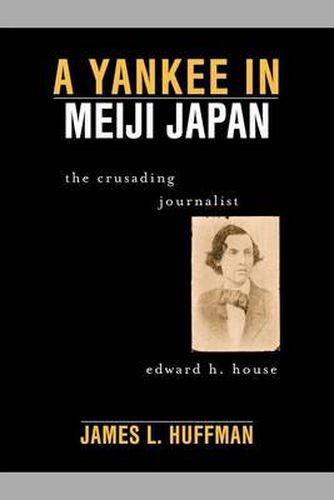Readings Newsletter
Become a Readings Member to make your shopping experience even easier.
Sign in or sign up for free!
You’re not far away from qualifying for FREE standard shipping within Australia
You’ve qualified for FREE standard shipping within Australia
The cart is loading…






This is an introduction to 19th-century Japan through the life story of Boston journalist Edward H. House (1836-1901), America’s first regular correspondent in Japan. House’s accomplishments were breathtaking in variety: shaping the reputations of John Brown and Mark Twain, influencing American attitudes toward Asia, persuading Congress to return a massive indemnity to Japan, editing Tokyo’s earliest English-language newspaper ( Tokio Times ), constructing a powerful case against imperialism and introducing Western orchestral music to Japan. House’s experiences also illustrated many of the era’s key themes: Japans use of public relations as a diplomatic tool, the contentious relations of the expatriate community, the role foreign advisors played in Japan’s drive toward modernity and the complicated nature of US-Japan relations. The book recounts the bohemianism that made House and his friends (Walt Whitman, Artemus Ward) notorious. It narrates his tender, tortured relationship with Aoki Koto, a girl he adopted when she was on the verge of suicide. It shows a courageous struggle with gout, including 20 years in a wheelchair given to him by the powerful Okuma Shigenobu. And it details a deep friendship with Mark Twain, which eventually was destroyed by a dispute over The Prince and the Pauper . Twain’s unpublished 50-pate manuscript on the experience, Concerning the Scoundrel, E.H. House is introduced here. Huffman draws on House’s voluminous writings and on hundreds of letters between House and major figures in both America and Japan, including Mark Twain, U.S. Grant, John Russell Young, Edmund Clarence Stedman, Okuma Shigenobu and Inoue Kaoru. Interweaving the life o house with the history of the Meiji era, this book aims to appeal to students, scholars and general readers interested in modern Japanese history and in America’s 19th-century foreign relations.
$9.00 standard shipping within Australia
FREE standard shipping within Australia for orders over $100.00
Express & International shipping calculated at checkout
This is an introduction to 19th-century Japan through the life story of Boston journalist Edward H. House (1836-1901), America’s first regular correspondent in Japan. House’s accomplishments were breathtaking in variety: shaping the reputations of John Brown and Mark Twain, influencing American attitudes toward Asia, persuading Congress to return a massive indemnity to Japan, editing Tokyo’s earliest English-language newspaper ( Tokio Times ), constructing a powerful case against imperialism and introducing Western orchestral music to Japan. House’s experiences also illustrated many of the era’s key themes: Japans use of public relations as a diplomatic tool, the contentious relations of the expatriate community, the role foreign advisors played in Japan’s drive toward modernity and the complicated nature of US-Japan relations. The book recounts the bohemianism that made House and his friends (Walt Whitman, Artemus Ward) notorious. It narrates his tender, tortured relationship with Aoki Koto, a girl he adopted when she was on the verge of suicide. It shows a courageous struggle with gout, including 20 years in a wheelchair given to him by the powerful Okuma Shigenobu. And it details a deep friendship with Mark Twain, which eventually was destroyed by a dispute over The Prince and the Pauper . Twain’s unpublished 50-pate manuscript on the experience, Concerning the Scoundrel, E.H. House is introduced here. Huffman draws on House’s voluminous writings and on hundreds of letters between House and major figures in both America and Japan, including Mark Twain, U.S. Grant, John Russell Young, Edmund Clarence Stedman, Okuma Shigenobu and Inoue Kaoru. Interweaving the life o house with the history of the Meiji era, this book aims to appeal to students, scholars and general readers interested in modern Japanese history and in America’s 19th-century foreign relations.